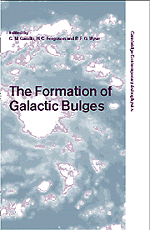Book contents
- Frontmatter
- Contents
- Preface
- Dedication: In Memory of Olin Eggen
- Part 1 Introduction
- Part 2 The Epoch of Bulge Formation
- Part 3 The Timescales of Bulge Formation
- Part 4 Physical Processes in Bulge Formation
- The Role of Bars for Secular Bulge Formation
- Bars and Boxy/Peanut-Shaped Bulges: An Observational Point of View
- Boxy- and Peanut-Shaped Bulges
- A New Class of Bulges
- The Role of Secondary Bars in Bulge Formation
- Radial Transport of Molecular Gas to the Nuclei of Spiral Galaxies
- Dynamical Evolution of Bulge Shapes
- Two-Component Stellar Systems: Phase-Space Constraints
- Central NGC 2146 – A Firehose-Type Bending Instability?
- Bulge Formation: The Role of the Multi-Phase ISM
- Global Evolution of a Self-Gravitating Multi-Phase ISM in the Central Kpc Region of Galaxies
- Part 5 Bulge Phenomenology
- Part 6 Conference Summary
- Index
Radial Transport of Molecular Gas to the Nuclei of Spiral Galaxies
from Part 4 - Physical Processes in Bulge Formation
Published online by Cambridge University Press: 10 November 2010
- Frontmatter
- Contents
- Preface
- Dedication: In Memory of Olin Eggen
- Part 1 Introduction
- Part 2 The Epoch of Bulge Formation
- Part 3 The Timescales of Bulge Formation
- Part 4 Physical Processes in Bulge Formation
- The Role of Bars for Secular Bulge Formation
- Bars and Boxy/Peanut-Shaped Bulges: An Observational Point of View
- Boxy- and Peanut-Shaped Bulges
- A New Class of Bulges
- The Role of Secondary Bars in Bulge Formation
- Radial Transport of Molecular Gas to the Nuclei of Spiral Galaxies
- Dynamical Evolution of Bulge Shapes
- Two-Component Stellar Systems: Phase-Space Constraints
- Central NGC 2146 – A Firehose-Type Bending Instability?
- Bulge Formation: The Role of the Multi-Phase ISM
- Global Evolution of a Self-Gravitating Multi-Phase ISM in the Central Kpc Region of Galaxies
- Part 5 Bulge Phenomenology
- Part 6 Conference Summary
- Index
Summary
The NRO/OVRO imaging survey of molecular gas in 20 spiral galaxies is used to test the theoretical predictions on bar-driven gas transport, bar dissolution, and bulge evolution. In most galaxies in the survey we find gas condensations of 108–109M⊙ within the central kiloparsec, the gas masses being comparable to those needed to destroy bars in numerical models. We also find a statistically significant difference in the degree of gas concentration between barred and unbarred galaxies: molecular gas is more concentrated to the central kiloparsec in barred systems. The latter result supports the theories of bar-driven gas transport. Moreover, it constrains the balance between the rate of gas inflow and that of gas consumption (i.e., star formation, etc.), and also constrains the timescale of the possible bar dissolution. Namely, gas inflow rates to the central kiloparsec, averaged over the ages of the bars, must be larger than the mean rates of gas consumption in the central regions in order to cause and maintain the higher gas concentrations in barred galaxies. Also, the timescale for bar dissolution must be longer than that for gas consumption in the central regions by the same token.
Introduction
Radial transport of gas in galactic disks likely plays an important role in the formation and evolution of bulges. There are two aspects in the effect of gas transfer to bulges, in both of which stellar bars are involved.
- Type
- Chapter
- Information
- The Formation of Galactic Bulges , pp. 132 - 135Publisher: Cambridge University PressPrint publication year: 2000



